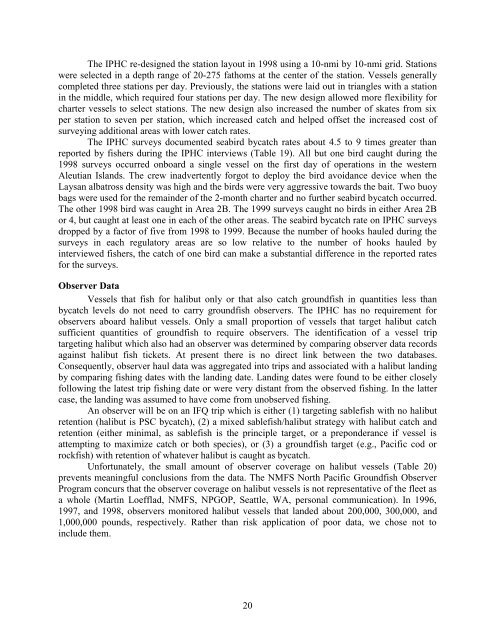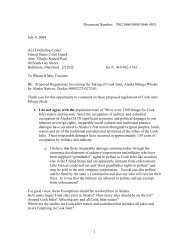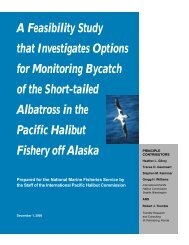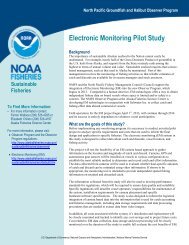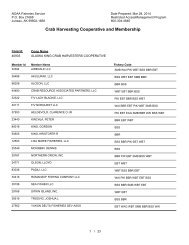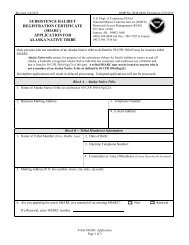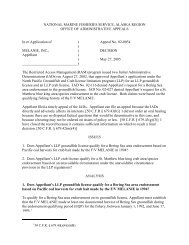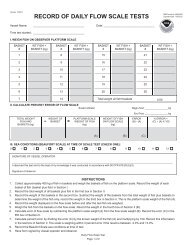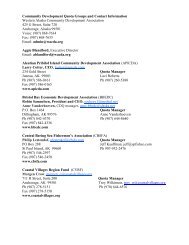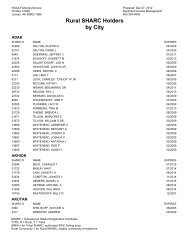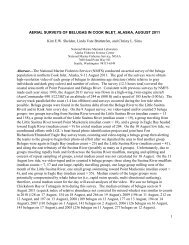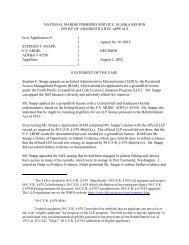Revised Report - National Marine Fisheries Service Alaska Region ...
Revised Report - National Marine Fisheries Service Alaska Region ...
Revised Report - National Marine Fisheries Service Alaska Region ...
Create successful ePaper yourself
Turn your PDF publications into a flip-book with our unique Google optimized e-Paper software.
The IPHC re-designed the station layout in 1998 using a 10-nmi by 10-nmi grid. Stationswere selected in a depth range of 20-275 fathoms at the center of the station. Vessels generallycompleted three stations per day. Previously, the stations were laid out in triangles with a stationin the middle, which required four stations per day. The new design allowed more flexibility forcharter vessels to select stations. The new design also increased the number of skates from sixper station to seven per station, which increased catch and helped offset the increased cost ofsurveying additional areas with lower catch rates.The IPHC surveys documented seabird bycatch rates about 4.5 to 9 times greater thanreported by fishers during the IPHC interviews (Table 19). All but one bird caught during the1998 surveys occurred onboard a single vessel on the first day of operations in the westernAleutian Islands. The crew inadvertently forgot to deploy the bird avoidance device when theLaysan albatross density was high and the birds were very aggressive towards the bait. Two buoybags were used for the remainder of the 2-month charter and no further seabird bycatch occurred.The other 1998 bird was caught in Area 2B. The 1999 surveys caught no birds in either Area 2Bor 4, but caught at least one in each of the other areas. The seabird bycatch rate on IPHC surveysdropped by a factor of five from 1998 to 1999. Because the number of hooks hauled during thesurveys in each regulatory areas are so low relative to the number of hooks hauled byinterviewed fishers, the catch of one bird can make a substantial difference in the reported ratesfor the surveys.Observer DataVessels that fish for halibut only or that also catch groundfish in quantities less thanbycatch levels do not need to carry groundfish observers. The IPHC has no requirement forobservers aboard halibut vessels. Only a small proportion of vessels that target halibut catchsufficient quantities of groundfish to require observers. The identification of a vessel triptargeting halibut which also had an observer was determined by comparing observer data recordsagainst halibut fish tickets. At present there is no direct link between the two databases.Consequently, observer haul data was aggregated into trips and associated with a halibut landingby comparing fishing dates with the landing date. Landing dates were found to be either closelyfollowing the latest trip fishing date or were very distant from the observed fishing. In the lattercase, the landing was assumed to have come from unobserved fishing.An observer will be on an IFQ trip which is either (1) targeting sablefish with no halibutretention (halibut is PSC bycatch), (2) a mixed sablefish/halibut strategy with halibut catch andretention (either minimal, as sablefish is the principle target, or a preponderance if vessel isattempting to maximize catch or both species), or (3) a groundfish target (e.g., Pacific cod orrockfish) with retention of whatever halibut is caught as bycatch.Unfortunately, the small amount of observer coverage on halibut vessels (Table 20)prevents meaningful conclusions from the data. The NMFS North Pacific Groundfish ObserverProgram concurs that the observer coverage on halibut vessels is not representative of the fleet asa whole (Martin Loefflad, NMFS, NPGOP, Seattle, WA, personal communication). In 1996,1997, and 1998, observers monitored halibut vessels that landed about 200,000, 300,000, and1,000,000 pounds, respectively. Rather than risk application of poor data, we chose not toinclude them.20


